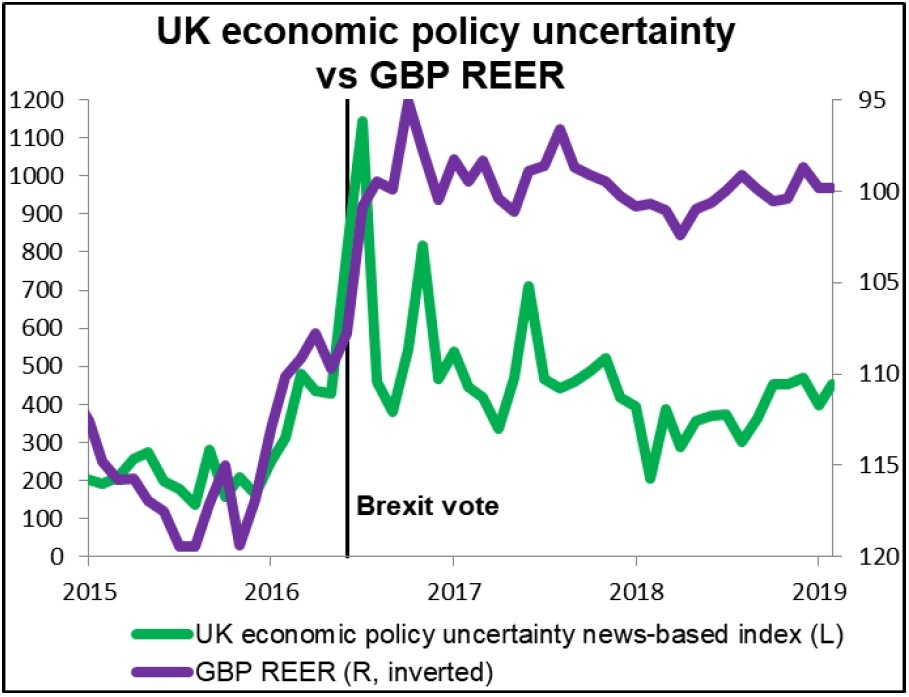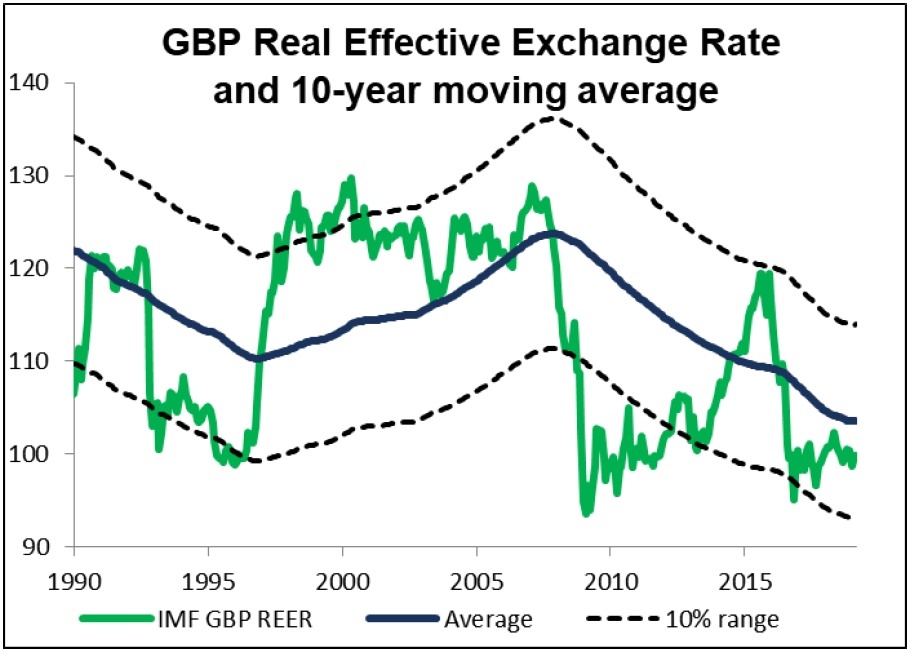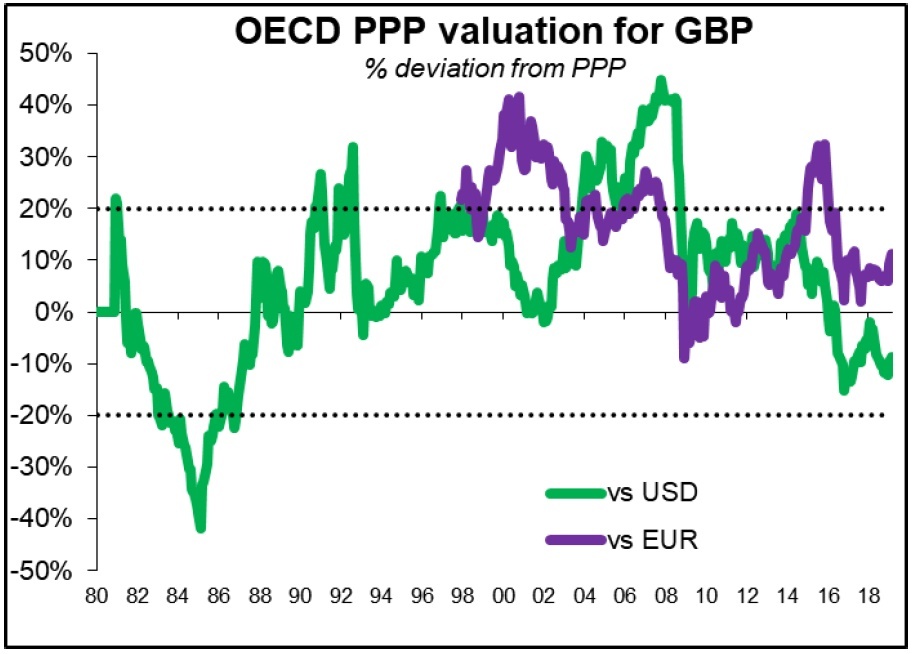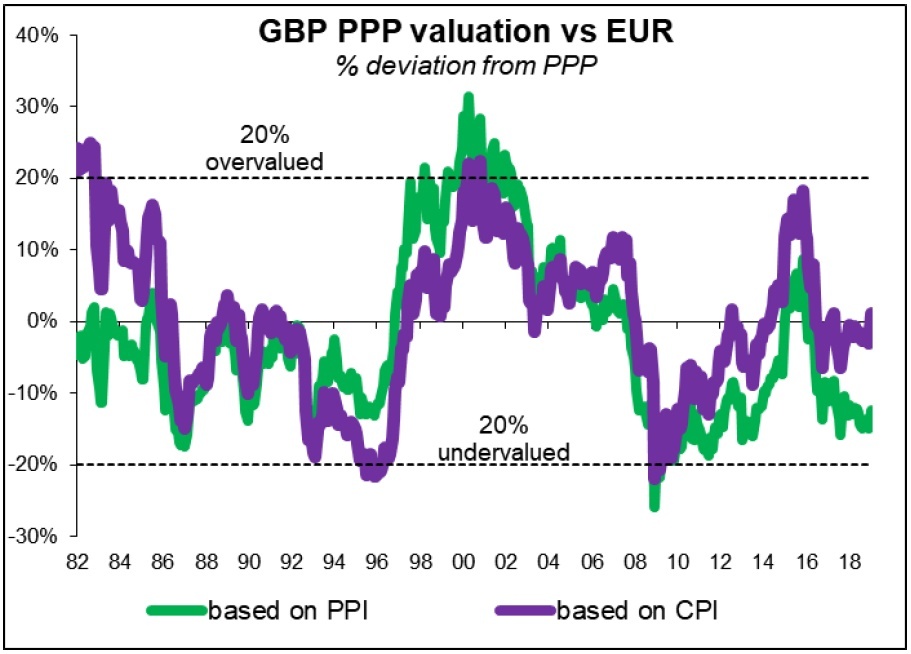This week, we see the long-awaited real, final vote on Brexit (maybe). There are three possible outcomes that we know of: PM May's deal, no deal, or an extension of uncertain length.
There's no doubt that uncertainty does impact the currency. That's clearly visible in this graph of the Baker, Bloom and Davis index of economic policy uncertainty, which is based on the frequency of newspaper references to policy uncertainty. You can see how this index jumped – and the value of the pound declined – following the Brexit vote. Since then though, the pound has seemingly adjusted to this "new normal" of uncertainty, remaining weak even though uncertainty has fallen back.
Nonetheless, the pound is still moving basically in line with perceived policy uncertainty, so we can't say at all that it has fully adjusted to this new uncertainty.
Where is the pound right now?
What is the pound likely to do in response to the vote? To figure that out, we first have to assess where the pound is right now.
Although the pound has fallen a lot since before the referendum, remember that that doesn't mean it's cheap. We don't want to commit the behavioral finance fallacy of anchoring. Just because a price used to be X and is now lower doesn't mean it's cheap – there's nothing to say that X was the appropriate price to begin with. (People fall into this trap a lot with Bitcoin – they believe it's cheap now that it's fallen from $19k to less than $4k. But is $4k a "cheap" price for something that was once worth pennies?)
The simplest way to value the currency is relative to its past value. The idea here is that what the currency "should" trade at is irrelevant – what's important is what it does trade at. For this exercise, we use the real effective exchange rate (REER), not the nominal rate. The REER is the value of the currency against all of the country's major trading partners, adjusted for inflation.
It's important because trade imbalances are one of the major factors moving currencies over the longer term. We also use a long-term average – 10 years – to avoid the "anchoring" problem.
On this valuation, GBP is 3.6% undervalued – hardly anything at all, and not what you would expect given the huge rise in uncertainty. In the past, 10% undervalued has sometimes been a barrier. That would mean the pound has another 6.4% to fall against the currencies of its major trading partners after inflation. This could be accomplished by a lower currency or it could happen through higher inflation, or both.
The more theoretical way of valuing the pound would be with purchasing power parity. That's as close a metric as we can get in forex analysis to seeing whether a currency is "fairly valued." And what that tells us is: the pound is fairly valued or even a little expensive! According to the OECD's PPP methodology, which takes a large basket of goods and services and prices them in different countries, the pound is around 8.6% undervalued vs USD but 11.2% overvalued vs EUR. And considering that the EU is Britain's largest trading partner (51.6% of total trade) vs 10.6% to the US and 7.6% to China, the two dominant USD trading partners, it's clear that the pound's value relative to EUR is the more important of the two prices.
The pound has tended historically to trade rich on a PPP basis, but there's nothing to say that it has to continue to do so. If we go by the usual rule of thumb for other currencies and see a 20% undervaluation as the limit, then that would mean EUR/GBP at £1.19! For GBP/USD to reach that level of undervaluation, it would mean going to $1.16.
If we take another approach and use the value of the currency as adjusted by the consumer price index (CPI) or producer price index (PPI), we get a slightly different result: it's fairly valued vs EUR on a CPI basis but somewhat undervalued on a PPI basis (-10.7%). The PPI basis is the more important, since that measures the prices of internationally traded goods, which is what's important for driving currencies back to PPP levels. On this basis EUR/GBP could go to £0.96 before hitting the 20% undervalued level that has previously been a barrier.
Recommended Content
Editors’ Picks
AUD/USD: Next stop emerges at 0.6580

The downward bias around AUD/USD remained unabated for yet another day, motivating spot to flirt with the area of four-week lows well south of the key 0.6700 region.
EUR/USD looks cautious near 1.0900 ahead of key data

The humble advance in EUR/USD was enough to partially leave behind two consecutive sessions of marked losses, although a convincing surpass of the 1.0900 barrier was still elusive.
Gold extends slide below $2,400

Gold stays under persistent bearish pressure after breaking below the key $2,400 level and trades at its lowest level in over a week below $2,390. In the absence of fundamental drivers, technical developments seem to be causing XAU/USD to stretch lower.
SEC gives final approval for Ethereum ETFs to begin trading

The Securities and Exchange Commission approved the S-1 registration statements of spot Ethereum ETF issuers on Monday, making it the second digital asset ETF to go live in the US, according to the latest filings on its website.
Commodity FX gets no help from higher US equities

Markets were all over the place on Monday. US equities put in a decent recovery, though this did nothing to help beaten down commodity FX, with the Australian Dollar, New Zealand Dollar and Canadian Dollar all getting hammered.




